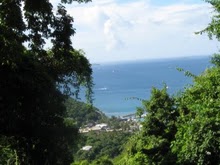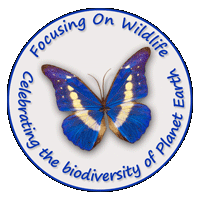 |
| Pair of Bald Eagles in the distance |
Jan 31, 2010
Bald Eagles
Have you ever done something out of reflex and then had the most unexpected and delightful result? This is exactly what happened to me one day when I set out in late fall hoping to spot any type of Hawks I would ordinarily be unlikely to see, except during migration season and hopefully get some pictures as well. I was actually not having much success, and was feeling quite disappointed, because all I had come home with, in the end was some pictures of Canada Geese in flight. I had been working far too many hours on my job, and hadn't truly had a chance to go birding very much during this particular migration period, so my disappointment was particularly acute.
Jan 28, 2010
Blue Heron
 |
| Blue Heron in flight over pond |
It is amazing, truly what you can see in the way of wildlife just by visiting a local park if you pay attention, and sometimes even if you don't. I had some time to kill before work one day and decided to visit the park just across the street to drink my coffee. It was predawn and already a warm day, and I only intended to watch the sun come up on the edge of the park, when I noticed an odd shape on top of a light post in the hollow of the park where the pond is.
Jan 27, 2010
American Coot
 |
| American coot foraging |
Jan 26, 2010
Northern Flicker
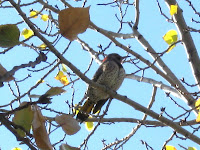 |
| Northern Flicker |
There are five subspecies of this bird, with two types of Northern Flicker
 |
| Looking up |
They feed on mostly insects, ants in particular with which they seem to also have a co-operative relation ship of sorts, as they have been observed letting ants crawl of over them. The theory is that the ants help rid them of pests. It is interesting to note that, just like an anteater, Northern Flickers have an extremely long tongue to help them feed on ants. If you wish to attract them to your backyard just install a suet feeder as they will feed on it, especially if your yard is populated with a few trees and bushes. Like all woodpeckers they will forage for bugs along tree trunks, and also occasionally feed on crickets, nuts, fruits and berries. Interestingly enough they have also been observed catching insects in flight.
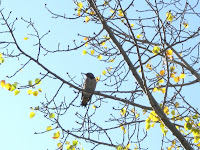 |
| Alert |
The Northern Flicker prefers open forests, groves and orchards and have been known to occupy city parks, and wooded backyards. They are known by alternate names such as Yellow hammer, Gaffer and Gawker bird. Being woodpeckers, they nest in tree hollows that they hammer out themselves, but will also occupy nest boxes created for them if they are of an appropriate size.
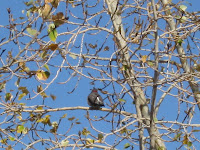 |
| Northern Flicker back view |
http://www.seattleaudubon.org/birdweb/bird_details.aspx?id=279
In addition you can view videos at this link if you are so inclined: http://www.squidoo.com/northernflicker
As you can see, although my abilities at photography is as yet somewhat limited, I did try to give you an all around view of this bird. Enjoy.
Susan
Jan 19, 2010
Eastern Kingbird
 |
| Eastern Kingbird |
As you can see in the picture this bird is grey to black on the back and light grey or white on the belly, with a lone white band edging its tail. What is rarely seen is a red patch on the top of its head. When I first saw the bird at the top of a tree from behind, I thought it looked like a crow except that it was too small, which made me curious. It was the white tail band that convinced me to snap the picture with my binoculars, before the bird disappeared on me. I was fortunate enough to get this second shot a few minutes later when I spotted it again. My digital binoculars do come in handy.
This is what I have learned about Eastern Kingbirds so far:
They are incredibly aggressive when defending their nests, even against larger birds like crows, raven and hawks. When the male attacks the female joins him in support. They have even been photographed perched on an eagles head, as if hitching a ride, as shown here: http://forums.dpreview.com/forums/read.asp?forum=1029&message=28374673
They tend to avoid urban areas, nesting in and around streams, along roadsides in trees and seem to also like to nest in orchards, especially apple trees. They prefer a habitat that consists of large open areas such as
meadows and fields. They thrive on insects, which they catch midair but will also hover over an area to hunt
for insects. To supplement their diets they also feed on wild berries. Their range of habitat is all across
Canada and the US and they migrate to South America in the fall, where apparently their behavior is quite
different, in that they tend to stay together in flocks.
If you wish to hear this bird's song follow this link: http://whatbird.wbu.com/obj/589/_/Eastern_Kingbird.aspx
Susan
Jan 3, 2010
Creating a backyard habitat for wildlife
Many people enjoy watching birds, butterflies  and other wildlife. Doing so can bring delight for small children and a kind of peace and relaxation for many adults. Wouldn't it be great to have the opportunity for this kind of joy, peace and relaxation in your life every day and to have the source close by? This is entirely possible.
and other wildlife. Doing so can bring delight for small children and a kind of peace and relaxation for many adults. Wouldn't it be great to have the opportunity for this kind of joy, peace and relaxation in your life every day and to have the source close by? This is entirely possible.
If you wish to attract birds and other wildlife to your home, it is necessary to tempt them to visit. You can do this easily by creating a habitat friendly garden or backyard, which has the added benefit of helping the environment and it isn't even as difficult as you might think initially. First you need to know what to plant. Planting native flowers, shrubs and trees is the best way to get started. There are many websites to help you choose plants specific to your location.
Next you need to consider the basic needs of wildlife, which are food, shelter, and water. You can add water quite simply by installing a bird bath or, if you feel ambitious, you can get creative and build a small, simple pond. Go here to learn how:
http://www.ehow.com/how_2297067_small-garden-pond.html
http://www.bukisa.com/articles/23372_how-to-create-a-small-garden-pond-in-a-container-pot-or-tub
Food sources for wildlife varies, but for birds there are specific types of fruit bearing trees that can be planted and specific types of birdseed and suet that can be placed in feeders or hung in the branches of trees, especially in winter. Butterflies and humming birds have different requirements. Depending on which type of wildlife you wish to attract and to find out what is needed you can easily search the web, but to get started go here:
http://www.avianweb.com/attractingwildlife.htm
The last thing you need to remember is to keep your newly created habitat chemical free. There are alternative means to dealing with potential pests, other than the use of chemicals, which are harmful to both yourself and the wildlife you are attracting. Just do a search on the web, or view my article on how to help migrating birds for more info. As you can see there is plenty of information out there for those of you who wish to attract some wildlife to your home environment and to help preserve the environment. Enjoy.
Susan

If you wish to attract birds and other wildlife to your home, it is necessary to tempt them to visit. You can do this easily by creating a habitat friendly garden or backyard, which has the added benefit of helping the environment and it isn't even as difficult as you might think initially. First you need to know what to plant. Planting native flowers, shrubs and trees is the best way to get started. There are many websites to help you choose plants specific to your location.
Next you need to consider the basic needs of wildlife, which are food, shelter, and water. You can add water quite simply by installing a bird bath or, if you feel ambitious, you can get creative and build a small, simple pond. Go here to learn how:
http://www.ehow.com/how_2297067_small-garden-pond.html
http://www.bukisa.com/articles/23372_how-to-create-a-small-garden-pond-in-a-container-pot-or-tub
Food sources for wildlife varies, but for birds there are specific types of fruit bearing trees that can be planted and specific types of birdseed and suet that can be placed in feeders or hung in the branches of trees, especially in winter. Butterflies and humming birds have different requirements. Depending on which type of wildlife you wish to attract and to find out what is needed you can easily search the web, but to get started go here:
http://www.avianweb.com/attractingwildlife.htm
The last thing you need to remember is to keep your newly created habitat chemical free. There are alternative means to dealing with potential pests, other than the use of chemicals, which are harmful to both yourself and the wildlife you are attracting. Just do a search on the web, or view my article on how to help migrating birds for more info. As you can see there is plenty of information out there for those of you who wish to attract some wildlife to your home environment and to help preserve the environment. Enjoy.
Susan
Subscribe to:
Posts (Atom)
